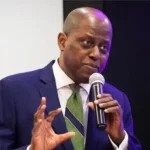By Simbo Olorunfemi
It looks like it has indeed been a full week for the President-elect since his return to the country after a deserved break following a rigourous period of campaign and election. Reports out there, which could have only captured in part the itinerary of the President-elect does suggest that it was a busy week, with the long list of political leaders and actors who were either at his residence or the Defence House to visit.
Even as that again confirms the transient nature of power and influence, as we see men who had power/influence yesterday working hard to ensure they find a place in the emerging power/influence grid. Interesting to see the new and emerging actors/centres of influence at play. With all that is going on in the open, not to talk of the more significant happenings behind the scene, it is easy to see the wisdom in the decision by the President-elect to stay away as long as he did.
Some will argue that he shouldn’t have even return yet, so he could better concentrate on pre-inauguration preparation with his core team, without the distraction that come with the throng of visitors. Yet, one must be mindful of his style and history, with a modus operandi in favour of constant personal engagement, even at enormous cost to his privacy and possibly well-being.
There lies what I think would be the most interesting, and perhaps challenging aspect of the Tinubu Presidency. That of finding a balance between the people-centric model that makes the President -elect the Jagaban with a most formidable and robust network of political actors under his wings and the governance-centric mindset, with keen interest in the policy formulation and execution process, usually with his own ideas and a mind of his own.
In a way, Nigeria has never had a President of his calibre. No President before him came in with the level of preparation he has, nor the kind of political legwork that saw him into office. None of those with such portfolio as his ever made it to the office. It will be interesting to see how he manages his extensive political constituency, in the face of the daunting task required of governance at this time.
In my study in the past, seeking to understand how balance is struck between governance and politics, I had identified what I called the Lagos model, in capturing the governance template that separated governance from politics, with the Governor largely insulated from the politics of the office and the State. The Lagos model, as I described it then, “perfected a system which dichotomises policy and politics.”
Having established this system which situates politics and governance on different pedestals, it will be interesting to see what template President Tinubu will adopt. Whereas with Lagos, his foot was in the shoe of politics with the shoe of governance in the foot of the Governor, he comes into office as President with his feet in both shoes. Will he eventually relinquish one of the shoes? Will he slightly pull his feet out of any of the shoes or even both?
Obviously, Lagos is not Abuja. Governing Lagos does not come with as much complexities and complications as governing at the national level. Even the convoluted nature of politics is much more pronounced at the national level. Yet, mismanagement of politics at the national level can be more consequential, with huge implications for governance and the President.
Presidents Obasanjo, Jonathan and Buhari had to handle politics their own way, each faced with unpalatable side-effects of power-play at the National Assembly and within the party itself? Would President Tinubu, a more astute politician than the ones before him, have to keenly manage politics at the national level? Can he afford not to? If he does, how will that impact his capacity to equally closely manage governance? If he doesn’t, will that not adversely impact capacity to deliver on vision, policy and even political plans?
There is a wide gulf between 1999 and 2023. Age and energy are not at the same level. The attention of the media is more turned towards governance at the national than sub-national. Trust in government has been seriously eroded. There was no social media then, there is now, with both positive and negative implications. The challenges are enormous.
Working with some members of his team years back, one lasting impression on my mind is the rigour in thought and preparation they felt compelled to invest in, in engaging the President-elect on what they described as lengthy debates on issues – policy and politics, with superiority of logic being the decider. That I saw play out, as well, in a direct encounter with him.
Seeing how convoluted the nature of the moment is, the importance of a strong core team, who understand how intertwined governance and politics is, peculiarly so for the President-elect, can only be imagined.
The choice of the Chief of Staff is key. One, in one breath, is thinking that a Technocrat with no active footprints in the political space will better serve him. In another breath, given how comfortable the Jagaban is in both boats, with one tendency reinforcing the other, will a COS who is detached from the political space not alienate the Principal from a pool he is comfortable swimming in?
Where are the Technocrats anyway? Most of the Technocrats he threw up yesterday have themselves now become politicians or professionals in politics. Does that better equip them for the task at hand? Does it disqualify them?
Perhaps the best option will be to have two principal offices or principal points of influence, each catering to either of the tendencies, confluencing in the President himself.
It is uncharted territory really. For the principal actor, the people around him and even us, students of the science of politics, who interrogate politics out of interest and fascination, the times ahead are definitely bound to be interesting times.









